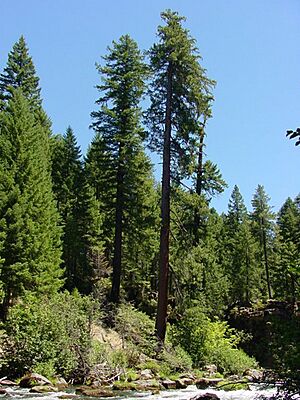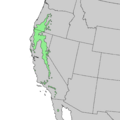Sugar pine facts for kids
Quick facts for kids Sugar pine Pinus Lambertiana |
|
|---|---|
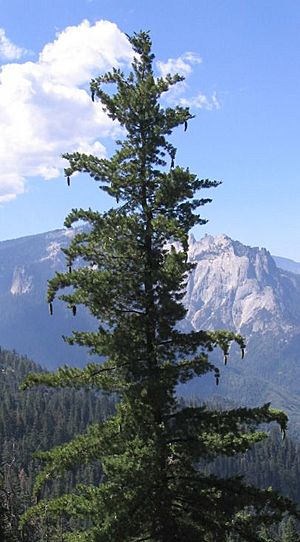 |
|
| Conservation status | |
| Scientific classification | |
| Genus: |
Pinus
|
| Species: |
lambertiana
|
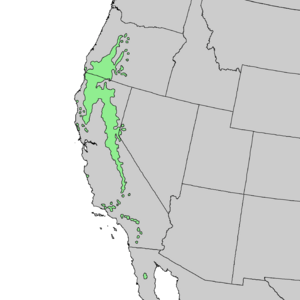 |
|
| Natural range of Pinus lambertiana | |
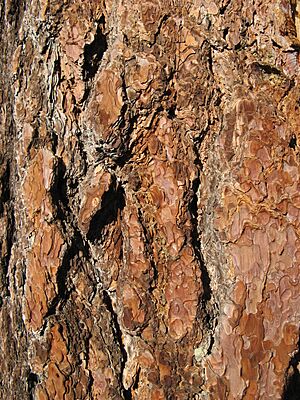
The Pinus lambertiana, often called the sugar pine, is a truly amazing tree. It is the tallest and heaviest pine tree in the world. It also has the longest cones of any tree that produces cones! The name lambertiana was given by a botanist named David Douglas. He named it after another English botanist, Aylmer Bourke Lambert. This giant tree grows in the mountains along the Pacific Coast of North America. You can find it from Oregon in the north all the way down to Baja California in Mexico.
Contents
Discover the Sugar Pine's Size
How Big Do Sugar Pines Grow?
The sugar pine is the biggest Pinus species. It usually grows to be about 40 to 60 meters (130 to 200 feet) tall. Some can even reach an amazing 82 meters (270 feet)! Their trunks can be 1.5 to 2.5 meters (5 to 8 feet) wide. The tallest sugar pine ever found was 83.45 meters (273.8 feet) tall. It was discovered in Yosemite National Park in 2015.
Sugar pines are part of the white pine group. Like other white pines, their leaves (which are like needles) grow in bundles of five. These needles are about 5 to 11 centimeters (2 to 4 inches) long.
Longest Cones in the World
One special thing about sugar pines is their cones. They have the longest cones of any cone-bearing tree! Most cones are 20 to 50 centimeters (8 to 20 inches) long. Some can even grow to 80 centimeters (31 inches) long. The seeds inside are 1 to 2 centimeters (0.4 to 0.8 inches) long. They have a wing that helps the wind carry them away. Sugar pines usually grow in forests mixed with other trees. They can also grow well in shady spots when they are young.
Where Sugar Pines Live
Sugar pines live in the mountains of Oregon and California in the western United States. They also grow in Baja California in northwestern Mexico. You can find them in places like the Cascade Range, the Sierra Nevada, and the Pacific Coast Ranges.
Threats to Sugar Pines
White Pine Blister Rust Fungus
The sugar pine has been badly affected by a disease called white pine blister rust. This is a fungus that came from Europe by accident in 1909. Many sugar pines have died because of this blister rust. This is especially true in the northern areas where the fungus has been around longer. This rust has also harmed other white pines like the Western white pine.
The United States Forest Service has a program to grow sugar pines that can resist this rust. They plant these special seedlings in the wild. The Sugar Pine Foundation, near Lake Tahoe, also helps. They find sugar pine trees that are naturally resistant to the rust. They show how important it is for people to help save this tree. Luckily, blister rust is less common in California. So, many sugar pines still grow there.
Mountain Pine Beetles
Sugar pine trees are also in danger from mountain pine beetles. These beetles are tiny insects that are native to western North America. The beetles lay their eggs inside the tree. This stops the tree from fighting off the beetles. The beetles also eat the tree's nutrients. This makes the tree weak and more likely to get other problems, like fires or fungal infections such as white pine blister rust. A tree weakened by blister rust can be easily attacked by these beetles.
How Climate Change Affects Sugar Pines
Sugar pine trees are dying more often because of drier weather and hotter temperatures. These trees grow in western North America, an area already affected by climate change. When it gets hotter, sugar pine trees produce less resin. Resin is like the tree's natural defense against diseases. Warmer winters also mean more pests and diseases can survive. Weak or dying trees can then become fuel for forest fires. These fires might become more common and stronger if summers get hotter and drier.
Protecting Sugar Pines
Sugar pine trees are slowly disappearing because of threats like white pine blister rust, mountain pine beetles, and climate change. Many groups, both government and non-profit, are working to save them. One non-profit group is the Sugar Pine Foundation. It started in 2004 to plant sugar pine seeds in the Sierra Nevada Mountains. They plant seedlings grown from seeds collected from trees that can resist the blister rust. They have tested over 500 sugar pines and found 66 resistant trees. It is very important to grow sugar pines that can fight off this fungus. This is because the fungus will keep killing many sugar pines otherwise.
The Sugar Pine's DNA
Scientists have studied the DNA (genome) of the sugar pine. It is one of the largest plant genomes ever studied! It has 31 billion base pairs. This huge genome has helped scientists learn more about how plant DNA changes over time.
What Sugar Pines Are Used For
Naturalist John Muir called the sugar pine the "king of the conifers." The tree gets its common name from its sweet sap. Native Americans used this sweet sap as a sweetener. John Muir even said it tasted better than maple sugar.
Native Americans also ate the sweet seeds of the sugar pine. The wood of the sugar pine has no smell. This makes it good for packing fruit or storing medicines. Its straight grain also makes it useful for making organ pipes.
Wildlife and Sugar Pine Seeds
Many animals love the large, nutritious sugar pine seeds. Yellow pine chipmunks and Steller's jays gather and hide these seeds. Chipmunks collect seeds that have fallen to the ground and store them. Jays peck the cones to get the seeds out. Even though wind helps spread the seeds, animals often collect them before the wind can carry them far.
Black bears in the Sierra Nevada mountains also eat sugar pine seeds in the fall. Bears will eat more sugar pine seeds or oak acorns depending on which food is more available that year. Both sugar pine and oak trees are declining. This could affect the food sources for black bears in this area.
Sugar Pine Stories
In the Achomawi creation myth, the creator, Annikadel, made one of the 'First People' by dropping a sugar pine seed. One of the people who came from this seed was Sugarpine-Cone man. He had a handsome son named Ahsoballache.
Ahsoballache married the daughter of To'kis the Chipmunk-woman. His grandfather wanted them to have a child. So, the grandfather broke open a piece from a sugar pine cone. He secretly told Ahsoballache to put what was inside into spring water. Then, Ahsoballache had to hide it in a covered basket. He did this that night. The next morning, he and his wife found a baby named Edechewe near their bed.
The Washo language has a word for sugar pine, simt'á:gɨm. It also has a word for "sugar pine sugar," nanómba.
Images for kids
See also
 In Spanish: Pino de azúcar para niños
In Spanish: Pino de azúcar para niños




